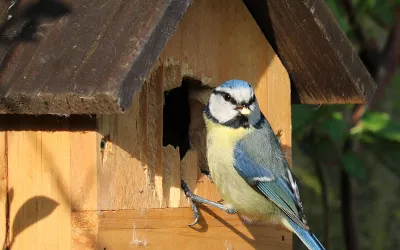
Tit and bird box
3. Do some tree spotting
It’s hard not to admire a tree in summer when it dazzles us with its foliage and flowers but trees in winter can be majestic too. See if you can find a silver birch, the maker of new woodlands, standing out with their shiny iridescent bark. Or check out a hornbeam with its grey bark – they stand out with their twisty gnarled trunks. Or maybe gaze in awe at an oak tree; these native trees support more species than any other and owe their high numbers to the Eurasian jay. This bird will collect fallen acorns and bury them further away. Though incredibly smart, the jay will bury so many acorns that they occasionally forget where one is hidden and then, the seed germinates. One of nature’s beautiful symbioses.
4. Take a safari
Check out the website of your local wildlife trust or conservation groups. Many run interesting safaris with expert guides giving you inside information on what to look for when out in the wilderness. In joining a safari, you will be able to soak up the wellbeing benefits and expand your knowledge, while also supporting conservation efforts near you. In Kent, you can walk with the longhorn and highland cattle at Heather Corrie Vale in Sevenoaks or take a bison ranger experience and learn about the UK’s ground-breaking Wilder Blean project.

5. Put the “fun” in fungi
This is the season for a fungi foray! It is literally all around, and when you start looking for it, you can’t stop seeing it! 2024's wet weather resulted in a poor year for insects and butterflies but created the perfect storm for fungi. Hothfield Heathlands in Ashford is home to over 1,500 species.
Why not find your local fungi interest group, download a guide, and head to the woodland to see what you can find?
Hothfield Heathlands winter fungi
Support conservation work
Our bonus tip for getting closer to nature this winter is to help us conserve it through supporting the work of Kent Wildlife Trust. Donate, volunteer or perhaps purchase a gift from our shop, it all helps us deliver a wilder Kent! If you are seeking that extra special gift, why not consider Legacy Landscapes - sponsorship of a quarter of an acre of a wildlife reserve in honour or memory of a loved one.

